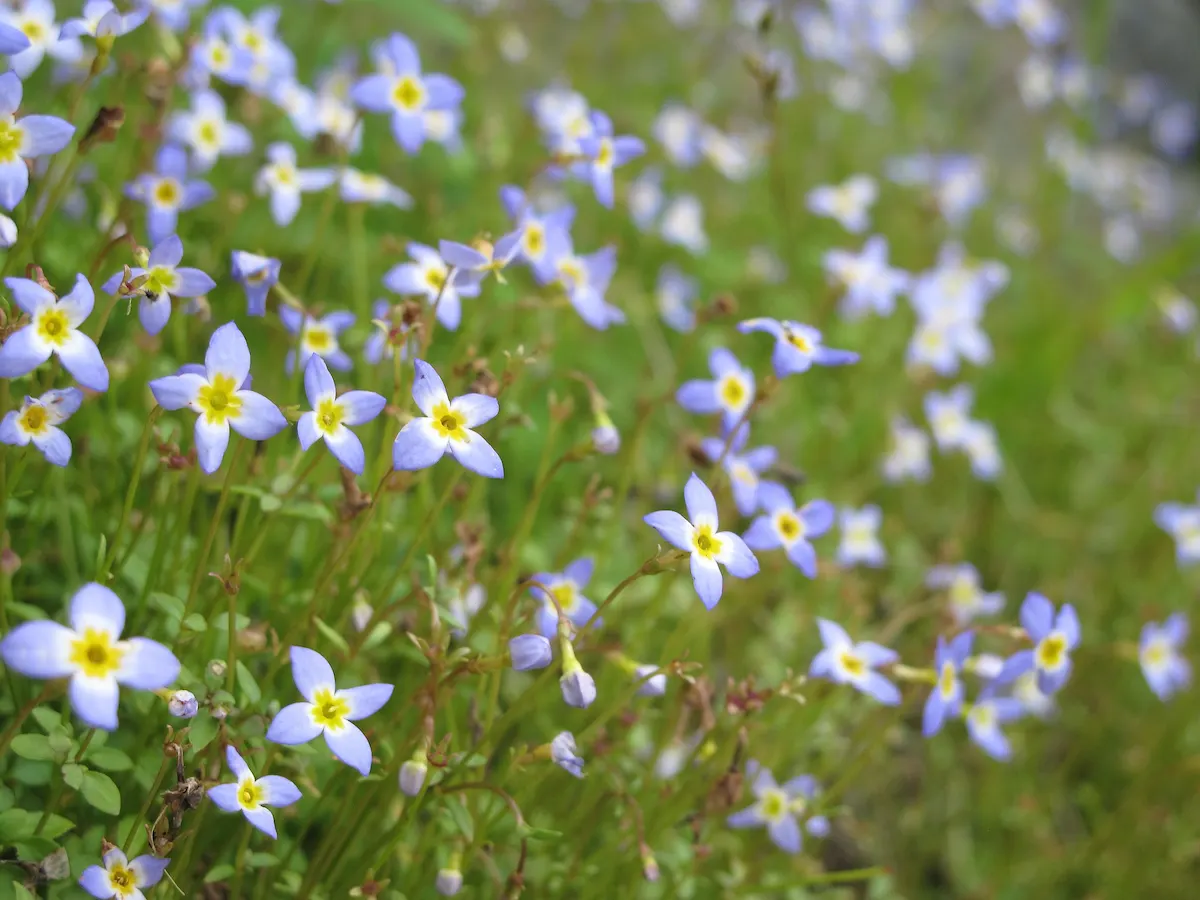Caring for and Propagating Bluets

U.S. Fish and Wildlife Service Southeast Region, Public domain
Bluets are low-growing perennials that have multiple blue or white-ish blooms with bright yellow centres. They are native to Quebec, Ontario, New Brunswick and Nova Scotia. They certainly are a feast for the eyes and they bloom anywhere between April and July. Bluets bloom for 2 or 3 weeks in the spring. Its plant helps filter water runoff. It makes a small contribution to stabilizing soil.
Bluets, Houstonia caerulea, with their beautiful blooms, are ideal as a ground cover or as a footpath lining. They are useful landscaping multitaskers since they also serve as live mulch. As known as Quaker ladies, they will carpet your garden plots elegantly. They will also act as a barrier against invasive weeds by suffocating them. Planting Quaker ladies on the sides of slopes in your yard can also stop the soil from eroding there.
Quick Growing Guide
Botanical Name: Houstonia caerulea
Also Called: Quaker ladies
En français: Houstonie bleue
Colour:
Blooms:
Sun / Shade:
Water: Regular water requirement.
Soil:
Pollinators:
The majority of eastern North America is home to the little blue wildflowers known as common bluets or azure bluets, Houstonia caerulea. Other bluet species can be found in some areas of eastern North America, but the common bluet is unquestionably the most prevalent and widespread species. Natural habitats for common bluets include open forests with slightly acidic, damp soils.
Bluets Appearance
Bluets are tiny, creeping perennial flowers that gather into tight-fitting tufts or mounds. Because how these blossoms resemble the caps that Quaker women used to wear frequently, they were given the nickname “Quaker ladies.” Bluet plants are most frequently seen with blooms in delicate colors of blue and white, but they can also be seen with blooms in pink, red, and purple, all of which have a yellow core.
Where to Plant Bluets
Bluets thrive in grassy areas and are an excellent choice for rock gardens, lawn replacements, and planting beneath taller blooms in the garden. Bluets can be grown in meadows, along paths, in semi-shade gardens, and even as a lawn replacement. They can also be used to keep invasive weeds at bay by choking them out. They are attractive to a variety of bees and small butterflies.
Caring for Bluets
Soil and Light
Bluets prefer soil that has a pH balance between 5.0 and 6.0 is somewhat sunny and shaded and is slightly acidic. Where bluets or quaker ladies thrive, the soil should ideally be moist but drain quickly. It is best to have organic soil that is sandy or thinly rocky. In the shadow given by big trees, this plant flourishes amid the mosses, adding color where many other flowers would weaken and die from lack of light.
Watering
During the spring and fall growing and flowering seasons, water bluets frequently. Regularly divide your bluets to produce more. While gardeners in cooler climates divide their plants in the spring, those in warmer climates will perform their propagating in the fall. Trim from time to time to remove dead leaves.
Propagating Houstonia caerulea
Plants disperse by seed, and they also spread through slender rhizomes, leading to the formation of clumping colonies. Most growth and development occurs during the spring.
Because they are so easy to transplant and the blossoms self-seed, a gardener will rarely need to start these plants from seed. If you find yourself in that situation, you can easily cultivate these plants from seed. Bluets are best planted on a cool, cloudy day or in the evening. They prefer moist, slightly acidic soils but can tolerate drought.
If you choose to begin with seeds, put them in a flat container and cover them with vermiculite. Place the flat container on the ground close to a north-facing wall, and then cover the top with glass or plastic. Keep the soil wet and check on your Quaker ladies frequently to detect the emergence of seedlings.
It typically takes three to four weeks for germination. Remove the container’s cover once the seedlings have begun to sprout. After a year of growth, move your Quaker ladies into their permanent location in the spring or the fall, spreading them 12 to 18 inches apart.
Pruning Houstonia caerulea
Bluets are easy to transplant. Propagate by dividing or simply letting them spread on their own through seeding and their rhizomes.
Other
There are no known pests or diseases.
Also known as Quaker Lady Bluets, due to the fact that their petals are shaped like the hats the women in the Quaker faith wore. It has also been said that the light blue petals matched the dresses that they wore.
Harvest and Uses
You can dry the bluets’ small flowers and add them to your own handmade potpourri. Simply allow the petals to completely dry on a sunny windowsill before placing them in a sealed container or Ziploc bag to keep them safe.
Bluets are used medicinally to cure gout and head lice, and they can also be made as tea to strengthen the bladder. The southern bluet and little bluet, which can form a blue-and-white quilt across the landscape, are two species of bluets that typically form a population with a single color shade.
Relation with Nature
Both nectar and pollen are produced by common bluets. Our native short-tongued bees can get their nectar thanks to their small flower tubes. Many native bee species will visit common bluets, including little carpenter bees and some of our sweat bees. Many of our smaller early butterfly species will also stop by common bluets.

